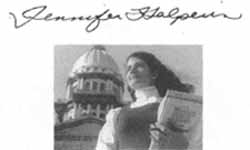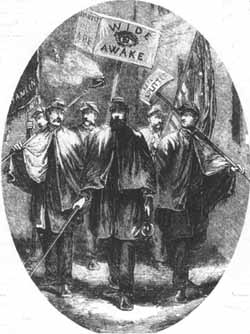STATE OF THE STATE
National leadership: Has our time come and gone? by Jennifer Halperin Recent geographical and philosophical shifts work against moderate Illinoisans getting the national spotlight. Abraham Lincoln employed one of the consummate tactics of successful politicking and leadership during his 1858 bid to become U.S. senator from Illinois: He tried to be many things to many people. In doing so, he was able to build coalitions and forge compromises. The main issue at hand, of course, was slavery. Illinois was a divided state at the time. Much of its northern half had been settled by abolitionist-minded New Englanders, while many people in its southern reaches, having made a living through some aspect of the slave economy, favored the practice. These varying sentiments reflected Illinois' role — one that continues today — as a microcosm of the country as a whole: part urban and industrial, part rural and agrarian; part progressive, part conservative. When Lincoln campaigned in Illinois' less tolerant regions, he built alliances on issues for the perceived greater good of his election. In doing so, he reflected the will of the people even as he tried to lead them. "Abraham Lincoln did not have the highest vision of human equality in his day," Garry Wills wrote in his 1994 book Certain Trumpets: The Call of Leaders. "Many abolitionists went farther than he did in recognizing the moral claims of slaves to instant freedom and something approaching a recognition of their human dignity.... [But] he knew that no one could be elected in or from Illinois if he espoused full equality for blacks, so he unequivocally renounced that position." Understanding the often racist views in the deep southern and southeastern regions of Illinois, "Lincoln calibrated what he had to say in those various places," Wills told Illinois Issues after Certain Trumpets was published. "And his general point that slavery should be stopped in the territory was something so important that he protected it by giving in to the [opinion] polls on all kinds of other things, saying, I'm not for black suffrage. I'm not for social equality. I'm not for intermarriage.' He went through all the things that he was not in order to get to the point that he could say, 'But don't you think we should stop slavery in the territory?'" This ability to appeal to different constituencies has been a hallmark of political success among Illinoisans. It's true that some rose to power through special proficiency, including General Ulysses S. Grant, whose military success helped propel him into the presidency. But many others, especially in more recent history, were known for their broad appeal, gaining power in Congress, for example, through an ability to reason and work with members on both sides of the political aisle, says Benjamin Ginsberg, a political science professor at Johns Hopkins University and director of the school's Center for the Study of American Government. "Illinois politicians practiced a politics of bipartisan consensus," he says. Former U.S. Sen. Alan Dixon, respected on a national level for his knowledge on defense issues, and former U.S. Senate Minority Leader Everett Dirksen, whose ability to work with both Republicans and Democrats earned him the nickname "The Great Conciliator," are two examples. "At the time, national leaders were not ideologues," Ginsberg says. "[Former House Minority Leader] Bob Michel would be the kind you'd usually produce: When it was five o'clock, he could cheerfully socialize with both Republicans and Democrats. Partisanship didn't dominate his thinking, nor did it for most of those who came to political maturity in Illinois." Recent geographical and philosophical shifts in leadership have worked against moderate Illinoisans' gaining national names for themselves. In the Newt Gingrich mold, more outspoken, ideologically extreme leaders are emerging. This has meant some national prominence for such Illinois conservatives as Congressman Henry Hyde of suburban Bensenville, who is chairing the GOP platform committee, as well as U.S. Reps. J. Dennis Hastert of suburban Yorkville, chief deputy whip in the House, and Jerry Weller of Morris. But it works against the tradition of the "bipartisan consensus" to which Ginsberg referred. "Illinois is a funny state because it's one of the few states with strong Democratic and Republican organizations," says Ginsberg. "During the 6 ¦ August 1996 Illinois Issues heyday of Richard J. Daley, for example, the Democrats controlled Cook County and the Republicans controlled the rest of the state, so there was a rough balance — a kind of accommodation between the parties so each got half the state's congressional seats." Historically, this moderate approach has been a key ingredient in the recipe for a national leader, says David King, a professor at Harvard University's Kennedy School of Government. "One thing to think about is whether a leader is supposed to be good at consensus-building," says King. "The ones we've had have had some success at it; traditionally, they've been successful at forging compromise, and some of their best friends are often on the other side of the aisle." The southward and westward shift in the country's population and power base, though, has helped push extremism in political leaders. Whereas Illinois has two strong parties — where a "go along, get along" attitude would be a prescription for success — aspiring politicians with radical ideas are more likely to gain media and public attention in "newer" states with one or no strong parties. "Illinois and some of the other older states do have a history of learning to divvy up the spoils of power," says Ginsberg. "Politicians in the Sun Belt learn to make a name for themselves by taking strong positions. Partly that occurs because those are the positions that get someone featured in headlines or television news reports." And, as more politicians started rising to prominence from these states, more extremism was seen on the national level. "The geographic change is a reflection of demographic and economic trends," says Ginsberg. "Political power follows the population and economic changes, which is one reason we've had two recent presidents who were governors from California — Richard Nixon and Ronald Reagan — and two who were governors from the south — Jimmy Carter and Bill Clinton. Leadership is coming more and more from the Sun Belt; that's a continuing phenomenon." It's one that has left Illinoisans shut out of the country's most prominent positions of late. There have been occasional cabinet seats, including Sam Skinner's appointment to secretary of transportation under President George Bush, and some visible posts, including William Daley's role as one of President Clinton's chief NAFTA lobbyists, but the main spotlights are shining elsewhere. "Bob Michel's kind of leadership, which was cultivated in Illinois and some of the older states, was rejected by the early 1990s," Ginsberg says. "Newt Gingrich represents a more ideological brand of leader who has strong partisan ideas. I don't see any evidence that partisanship is diminishing yet. It's likely we'll see continuing partisan rancor." That doesn't mean a leader from Illinois is out of the question in the near future. The state's legislative chambers have become fairly bitterly divided along partisan lines, and leadership there has taken a turn toward the ideological. But as Clinton and GOP presidential hopeful Bob Dole take steps toward the middle — Clinton with his support for a gay marriage ban, for example, and Dole through his intimation that he would oppose a repeal of the federal assault weapons ban — there seems to be room for moderation in politics. Illinois may not have the population boom of the Southwest or the hard-line representation of a [U.S. Senate Majority Leader] Trent Lott, but unforeseen circumstances can produce unexpected leadership. After all, during a time when most leaders came from the established and enlightened eastern states, who would have thought the United States would find its most respected historical leader in a Midwestern log-splitter named Abraham Lincoln?
Illinois Issues August 1996 ¦ 7 |
||||||||||||||


 The Wide-Awakes, the first association of young Republicans,
helped Abraham Lincoln win the nomination in Chicago in
1860. A few months before the convention, a group of young
activists grabbed capes and torches from the local fire department in Hartford, Conn., in order to provide an escort for Cassius M. Clay, the staunch Republican from Kentucky who was
to speak at a rally. The impromptu march sparked a brushfire
of support across the country. The members, who all wore uniforms, were militant in appearance. That uniform, costing 75
cents, consisted of a black cape trimmed in white and a glazed
cap with a white hand. But the dominant symbol of the group
was a lantern. Drawing a comparison to Gideon's defeating the
enemies of Israel, the Wide-Awakes believed they could defeat
the enemies of the Republicans with a lantern and a ballot.
The Wide-Awakes, the first association of young Republicans,
helped Abraham Lincoln win the nomination in Chicago in
1860. A few months before the convention, a group of young
activists grabbed capes and torches from the local fire department in Hartford, Conn., in order to provide an escort for Cassius M. Clay, the staunch Republican from Kentucky who was
to speak at a rally. The impromptu march sparked a brushfire
of support across the country. The members, who all wore uniforms, were militant in appearance. That uniform, costing 75
cents, consisted of a black cape trimmed in white and a glazed
cap with a white hand. But the dominant symbol of the group
was a lantern. Drawing a comparison to Gideon's defeating the
enemies of Israel, the Wide-Awakes believed they could defeat
the enemies of the Republicans with a lantern and a ballot.